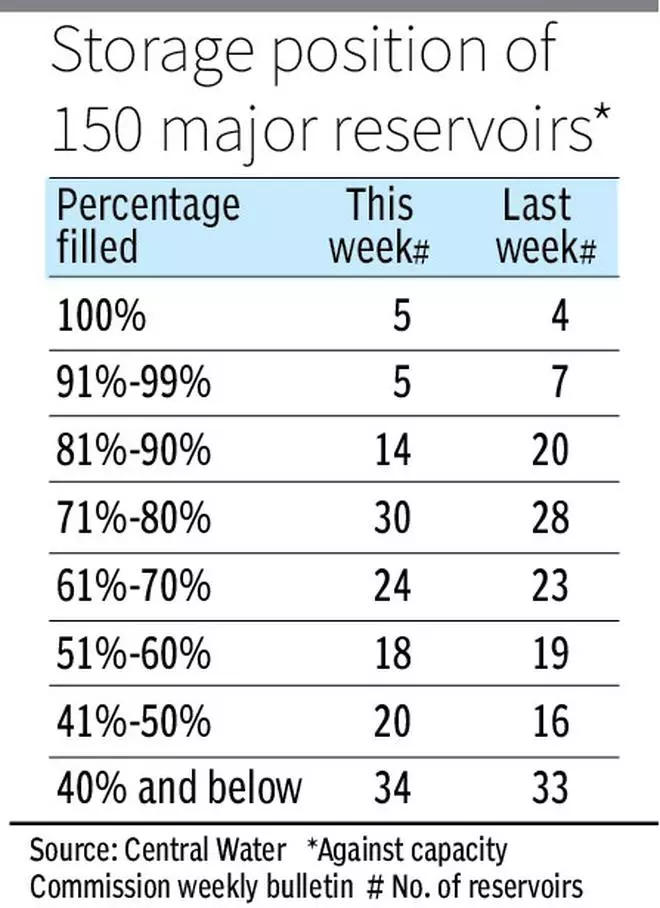The water level in the 150 major Indian reservoirs declined for the 14th week in a row with the storage in South India dropping to below 40 per cent.

Odisha joined the list of States with storage being lower than normal to raise the total to 11, while the number of reservoirs where the water level is below 40 per cent of the capacity increased to 34 from 33 a week ago.
According to the weekly bulletin on live storage status of the reservoirs issued by the Central Water Commission (CWC), the water level in the 150 major reservoirs this week was 102.162 billion cubic metres (BCM) or 57 per cent of the total capacity of 178.784 BCM.
Rabi rice in trouble?
Last week, the storage was 105.273 BCM or 59 per cent of the capacity. A year ago, the level was 81 per cent and the last 10 years average position is 95 per cent - a clear indication of the gravity of the situation.
Though the situation is not worrisome for North India since the ice melting in the Himalayas could flow and help the States there, South India could face problems, particularly with rabi rice and pulses, an agriculture expert said.
“Kerala relies on Tamil Nadu for red rice - Uma. It could be a problem. While people in the South may have to pay more for idli rice since its production could be affected,” the expert said.
Some comfort in central region
Of the 42 reservoirs in the southern region, 19 have level less than 40 per cent of the capacity, while another four have less than 50 per cent. The level this week dropped to 39 per cent (40 per cent last week) of the 53.334 BCM capacity at 20.590 BCM.
The central region is another one where the second-highest number of reservoirs — seven — have a level below 40 per cent of the capacity among the 26. The situation is better than last week when the storage in eight reservoirs was below 40 per cent.
The storage in the region, which includes Uttar Pradesh, Uttarakhand, Madhya Pradesh and Chhattisgarh, is 66 per cent (67 per cent) of the 48.227 BCM capacity at 31.745 BCM.
The western region, including Gujarat and Maharashtra, saw the level drop to 69 per cent (71 per cent) of the 37.130 BCM capacity at 25.437 BCM. The storage in four reservoirs was below 40 per cent of the 49 against three last week, while no reservoir was filled to capacity unlike last week when one was full. While the level in Gujarat declined by 2 per cent points to 36 per cent above normal this week, the situation in Maharashtra improved to 9 per cent below normal from 10 per cent.
Deficient rainfall since Jan 1
In the 23 reservoirs in the eastern region, the level in three was full, while in another three it was below 40 per cent. The storage in Assam is more than double the normal, while it is 16 per cent below normal in Nagaland.
Of the 20.430 BCM capacity in the region, the storage was 68 per cent (69 per cent) at 13.814 BCM. The region also saw the level dropping below normal in Odisha after a gap of a couple of weeks.
The 10 reservoirs in the northern region were filled to 54 per cent (57 per cent) of the capacity at 10.576 BCM against the 19.663 BCM capacity. No reservoir was filled above 80 per cent of the capacity, with the level in Punjab being 38 below normal.
Though the peninsular region has received excess rainfall since the beginning of the year, data from 711 districts collected by India Meteorological Department show that 75 per cent received deficient, large deficient or no rainfall.
According to the National Centres for Environmental Information, an arm of the US National Oceanic and Atmospheric Administration, 26 per cent of the country was going through a prolonged dry period till December.




